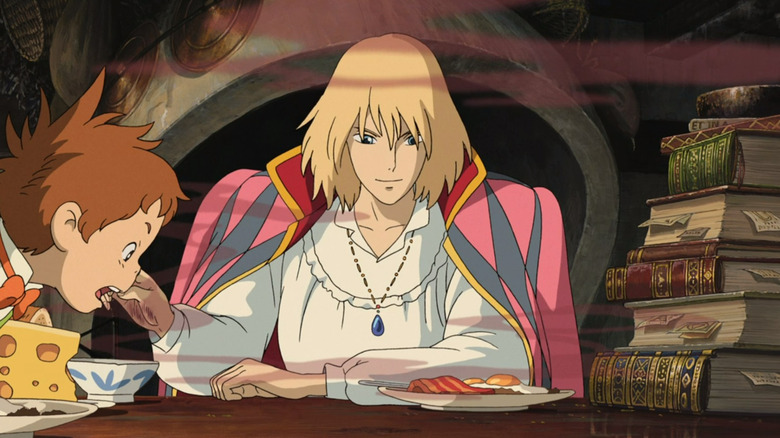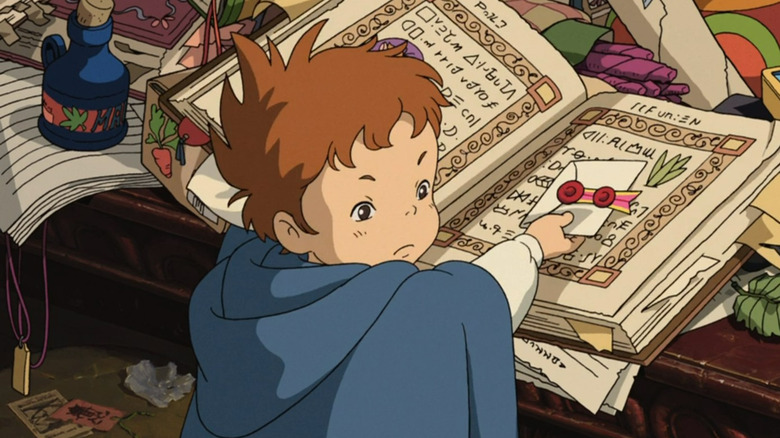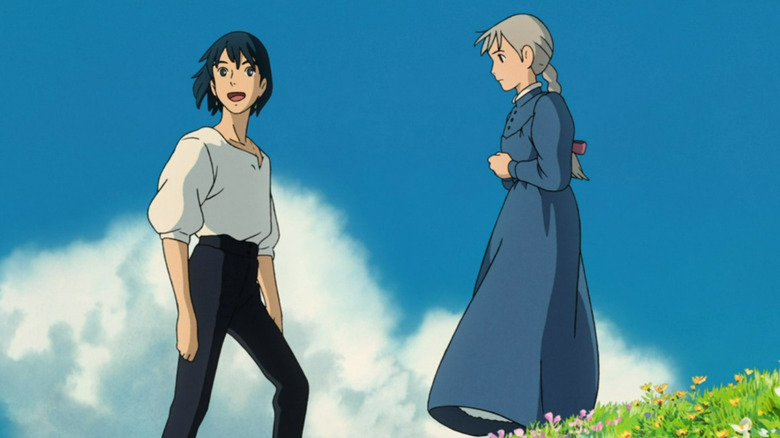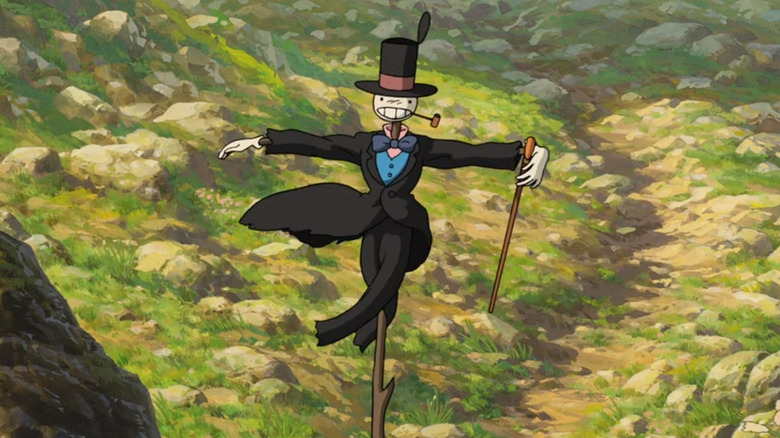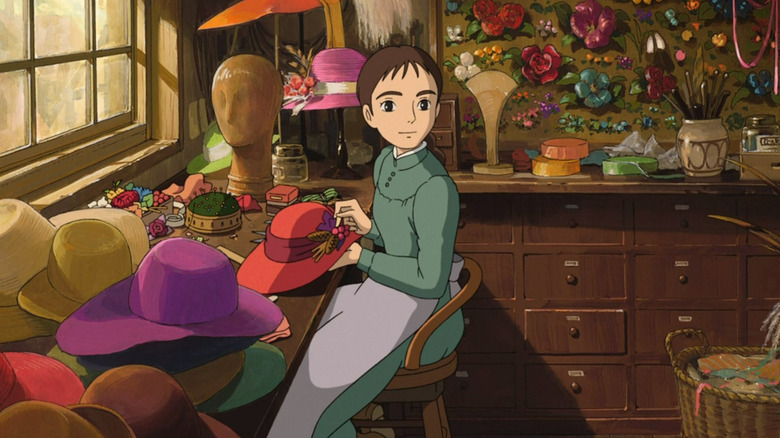Howl's Moving Castle: How Closely Does Studio Ghibli's Film Follow The Book?
In 2004, Studio Ghibli released "Howl's Moving Castle," an award-winning animated film based on Diana Wynn-Jones' 1986 novel of the same name. As Ghibli fans should know, the story follows Sophie Hatter (Emily Mortimer and Jean Simmons), a gentle young woman cursed by the vainglorious Witch of the Waste (Lauren Bacall) to appear as an "ugly" old woman. Meanwhile, Sophie becomes smitten with the even more vainglorious wizard Howl Pendragon (Christian Bale), who is in possession of a wise-cracking fire demon (Billy Crystal) and a moving castle.
It's a cozy fantasy with beautiful scenery and a rich narrative, so it's a little shocking to realize that it strays from the source material in almost every possible way. Before delving any deeper, it's important to note that this isn't a critical piece, only an observational one.
While the previously shared brief synopsis holds true for both iterations of "Howl's Moving Castle," almost every other aspect of the Studio Ghibli film branches into different territory. A comprehensive list of all the notable changes would turn into a novel itself, so here are a few of the most glaring differences to share here.
Markl replaces Michael Fisher onscreen (and loses his romance plot with Sophie's sister)
In Studio Ghibli's animated film, Howl Pendragon employs young Markl (Josh Hutcherson) as his apprentice. Markl is best described as a diminutive and excitable child with pale skin and ginger hair who clumsily barrels his way through every task that Howl assigns him. Although his exact age is never offered, he can't be older than 10, which is made all the more evident by how he essentially adopts Sophie Hatter as his mother.
In the novel, Markl does not exist — instead, there's Michael Fisher, an ambitious teenager in the service of Howl. Wynn-Jones describes Michael as a tall young man with dark skin and an open face. The language Wynn-Jones uses, especially in regard to Michael not looking "servile," suggests a certain level of fantasy racism that cannot be properly addressed in this space, so just be aware that her terminology does not hold up under scrutiny.
Where Markl becomes Sophie's pseudo-son, Michael becomes her future brother-in-law by entering into a relationship with Lettie Hatter, Sophie's sister. Technically, he's in a relationship with Martha Hatter, Sophie's other sister, but he doesn't know that because the two magically swapped places so that they might pursue their preferred futures, instead of the futures their mother assigned them. It's all very "Pride and Prejudice" meets "Freaky Friday."
Studio Ghibli added a war subplot to give Howl Pendragon something to stand for
Onscreen, the land of Ingary is ravaged by war (it happens in just about every Hayao Miyazaki film) ... magic and machines are used in lethal combination, and the skies are full of smoke and monsters. Howl Pendragon wants no part of it. But, at every step, he's dogged by the crown, which is desperate to claim him as a soldier. Eventually, Howl gives in, but only because he realizes that his hatred for war might be better suited to ending it, rather than avoiding it. In Diana Wynn-Jones' novel, however, there was never a war to begin with.
The only aspect of this particular plotline that is consistent across both versions of "Howl's Moving Castle" is how the crown wants to own the titular character. In the animated film, Madame Sulliman (Blythe Danner) insists on securing her old pupil for the war efforts but, on the page, the nameless King of Ingary simply wants Howl for himself, because who doesn't want a powerful wizard in their back pocket?
In both versions, Howl sends Sophie Hatter as his vassal to discourage any further inquiries into his potential "employment." Hilariously, on the page, Sophie fails so miserably at this task that the King of Ingary doubles down on his desire to indenture Howl. Which is exactly the kind of karma that a petulant wizard deserves.
Howl Pendragon leads a double, interdimensional life in the novel
Studio Ghibli's version of Howl Pendragon trained to be a powerful wizard from a young age. And become one he did — Howl earned a name for himself through his unparalleled magical prowess. It's the kind of legacy that is only built with time and a steady — if not dramatic — presence. And that's just not something Book Howl could ever have earned because he divides his time between two worlds.
Howl is not from Ingary in the novel. He's not even from whatever fictional world Ingary is in. He's from Earth. Our Earth. Wales, specifically, where he's known more subtly as Howell Jenkins, his true name. Howell is a Ph.D. student who enjoys college rugby and hates studying. He's still a petulant, womanizing, interdimensional wizard but that's more of a hobby than anything else.
Which leads us to the black door portal. Onscreen, it serves as a connection point between the present and the past but, on the page, it's how Howell traverses between worlds. There's a bizarre moment where Sophie Hatter follows Howl back through to discover that he's just a dude who lives with his sister and her son. It's made a little sweeter by how Howell uses his time in Ingary to create video games for his nephew, though.
Turnip-Head gains new significance onscreen and saves the prince a great deal of pain
In Studio Ghibli's animated film, Turnip-Head (Crispin Freeman) is an adorable scarecrow that follows Sophie Hatter around Ingary. He's fast, too, even catching up to Howl Pendragon's literal moving castle on multiple occasions. It's later discovered that he's actually a prince who's been cursed, a curse which is broken when Sophie kisses him on the forehead. Upon becoming human again, he vows to return home to help end the war. It's a gentle bow that ties together an already happy ending and it's very, very different from what happens on the page.
In the novel version of "Howl's Moving Castle," Turnip-Head possesses no name; he's merely an enchanted scarecrow. He seems to like Sophie since he follows her around. He still helps her whenever he can, but he's no prince in disguise, just a sentient stick. Speaking of the prince ... the poor guy suffers a far worse fate on the page. He's harvested for body parts by the Witch of the Waste who's trying to create the "perfect being." Ironically, the prince's body is combined with the body of Wizard Sulliman, who is later narratively combined with Mrs. Pentstemmon, Howl's old tutor, in the film to create Madame Sulliman.
Sophie Hatter has magical abilities in the novel but she mainly uses them accidentally
Sophie Hatter is implied to be a magical being in Studio Ghibli's "Howl's Moving Castle." It's not an aspect of her character that's treated like a mystery, rather it's just a hint of something more which draws those around her in.
In Diana Wynn-Jones' novel, Sophie's powers are more directly called into focus by Mrs. Pentstemmon, who informs Sophie that she is basically a minor god with zero motivation. That's because Sophie can will truths into existence. She determines the future of those who would buy her hats simply by imagining how their lives should be. She accidentally bestows a scarecrow with sentience. She unknowingly transforms a walking stick into a magic wand.
Perhaps the worst realization is that Sophie's magic can be self-inflicted. The curse laid upon her by the Witch of the Waste is prolonged by her low self-esteem because when she sees herself as an old woman, it matches how she feels about herself. And that stubbornness is more powerful than Howl's attempts to break the spell.
When Sophie finally gains some semblance of control over her abilities, she destroys the contract between Calcifer and Howl without killing either of them, something that was supposed to be impossible to do.
